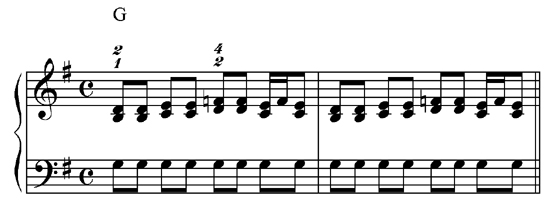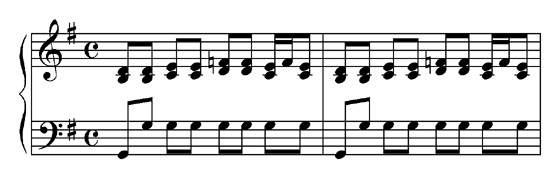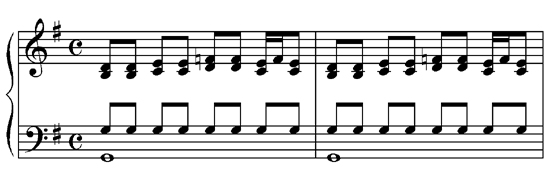Musicarta Twelve-bar Piano Styles
Moving Pair - Module Four
This Moving Pair riff module livens up the left hand with some octaves and ‘anticipation’ (playing ahead of the beat) and develops the twelve-bar chord sequence in a way you’re sure to find familiar.
Here’s the performance version you build up to.
Do you hear the new off-beat notes in the left hand?
Left hand octaves
An octave is the closest pair of same-name notes on the keyboard. ‘An octave’ can mean either such a pair played at the same time or one note at a time.
Pianists usually play octaves with fingers 5 (little finger) and 1 (thumb). It’s often the biggest stretch the hand can comfortably make.

Next, explore giving your performance more ‘shape’ by marking the start of each bar with an octave in the left hand.

If you can’t stretch an octave (that is, play both Gs at the same time), play the low G with the little finger (LH5) on the first beat of the bar and fill the rest of the bar up with thumb Gs.

You will probably need to practice your octave jumps. Set off for the new bass note early enough to get there on time – missing out a few thumb notes to get there is fine.

If you can stretch an octave in your left hand, you have the option of leaving the low G down right through the bar. This really is an improvement – it sounds like there’s a bass guitar playing as well.

Anticipating in the left hand
Another option for varying and improving the Moving Pair riff is ‘anticipation’ of the beat in the left hand.
At its simplest, the first bass note in every bar (except the very first) is ‘anticipated’ – pulled forward into the previous bar and played:
- before its ‘proper’ beat,
- on its own,
- between two right hand chords
Here is a build-up to help you get the trick.
Written-out music of off-the-beat playing is very confusing to look at – much better to just copy the audio and watch on MidiPiano until you get it.
Practice playing with the left hand off the beat all the time. Simplify matters by dropping the right hand ‘kick’ for now.
Try the thumb anticipated all the time, with some extra tied notes within the bar. Try to feed the right hand ‘kick’ back in.
Note that when you play the thumb anticipated and put the right hand kick back in, the right hand kick note and the anticipated left hand thumb come together (previous clip)
Go back to the build-up to get back onto the beat.
Try the thumb anticipated (first beat only), and the little-finger octave on the beat.
Try the little-finger octave on the beat (and held…!), with the thumb anticipating some of the notes within the bar.
The possibilities are endless! Keep practising, and expect to take a while getting something worth having. Use a drum loop or a metronome/click track to help you tighten up the timing. It doesn’t matter if your version is not quite as described above, as long as it’s in time and you’re enjoying playing it.
The module riff demonstrates all the left hand developments described above.
The chord sequence developed
The third new element in the improved Moving Pair riff involves the chord sequence. If you’ve listened to the latest version of the Moving Pair riff carefully, you’ll have already heard it – at the end of the chorus.
So far, we have been working with the very simplest 12-bar chord sequence. The most likely harmonic development of the twelve-bar chord sequence is in bar 12. In the key of G, this would become a bar of chord D, making this chord sequence:

Listen to the module riff again and match up what you see with what you hear.
In this instance, you don’t play ‘the pattern’ in the last bar – just the root D in both hands.
Watching the performance in MidiPiano will show you exactly what the hands play, and when. You can play bar 12 without the anticipation initially, if you want.
Module summary
There is a lot of new material in this module.
It's unlikely that just seeing hands work through it all will help you much, so the module video just shows you parts of the module MIDI files played at practice speed on MidiPiano.
With 'Repeat' on, you can play along, joining in again and again
until your muscles give in and let you play what you hear (!!). Find
time to make MidiPiano part of YOUR practice set-up!
It’s more important – and more satisfying! – to play only an ‘approximation’ of the new riff variations in these modules and keep going, than it is to insist on playing all the notes in the audio/MIDI performances and being disappointed and frustrated. “A bird in the hand is worth two in the bush” is the English proverb.
There’s a Russian proverb, too:
“You learn to ski in summer; you learn to swim in winter.”
That seems bizarre, but it’s often true of practising. It often seems to be between practise session that the ability to play what you’ve been practising actually finds a home in your muscles.
Either way,
“Rome wasn’t built in a day!”
Practising and learning are long-term commitments. You have to believe you’ll succeed in the end and that the effort will have been worth it.
|
OUT NOW! |
THE MUSICARTA BEAT & RHYTHM WORKBOOK At last! An effective approach to keyboard rhythm & syncopation skills. Learn more! |
ONLY $24.95! |
TWELVE-BAR |
The MusicartaA methodical approach to keyboard syncopation for
|
PUBLICATIONS
exciting keyboard
creativity courses
CHORDS 101
WORKBOOK

~HANON~
video course

Musicarta
Patreon
PENTATONICS
WORKBOOK
video course

Creative Keyboard
video course

BEAT AND RHYTHM
WORKBOOK

- Volume 1 -

12-BAR PIANO
STYLES WORKBOOK

MUSICARTA MODES
WORKBOOK

PIANO STYLE

CANON PROJECT
video course

VARIATIONS
video course


- Piano Solo -
video course

- Piano Solo -


YouTube playlists





 THE LOGO
THE LOGO
